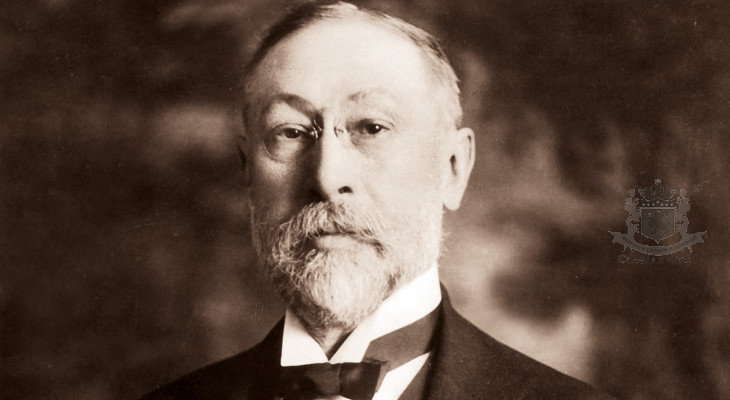Boldt George C. of the Waldorf
( words)
For more than a century the name Waldorf-Astoria (spelled Waldorf=Astoria these days) has been renowned. When established at the end of the nineteenth century it was not merely the largest hotel in the world, but one of the most advanced and prestigious.
Proprietor George C. Boldt was called “the inventor of the modern hotel.” Although he was responsible for many operational and technical innovations, the glamorous and luxurious character that accounted for the fame of the New York City institution was due in large part to his wife, Louise Kehrer Boldt, a working partner in their early hospitality venture. George Boldt, almost an exact contemporary of César Ritz, was his equivalent in the New World. Similarly, Boldt and his wife transformed the conventional hotel in a new type of civic center that attracted the social elite. Beyond providing food and lodging to transients, at a time when new wealth was gravitating to New York, the Waldorf provided status to those aspiring identity with a privileged class.
The initial impetus for Boldt’s amazing career was an accident of birth. Georg Carl Boldt was born in 1851 on the German island of Rügen in the Baltic Sea. There the local prince had built an elegant resort, attracting summer sojourners from Berlin. Boldt had hospitality in his blood. George Boldt came to America alone at the age of thirteen, going to work as a kitchen helper at a small hotel in New York City. His story is a familiar tale of rags-to-riches success. George Boldt died a fabulously wealthy and prominent celebrity. Traffic on Fifth Avenue was stopped for his funeral cortege, proceeding from the Waldorf-Astoria to the church, where some of the most famous and powerful men in America served as pall bearers. Louise Kehrer Boldt, born in Philadelphia, was daughter of a German-born tavern keeper there. William Kehrer became Steward of the exclusive Philadelphia Club, the oldest men’s club in the United States. Kehrer engaged Boldt as his assistant. When George married Louise, wealthy members of the club assisted them in establishing a small hotel in Philadelphia, the Bellevue.
Connection with the Philadelphia elite assured a social cachet, but more importantly Louise Boldt sensed that wives of wealthy husbands wanted to escape from the domestic confinement prevalent at the time. She introduced novel features, such as cut flowers and candles on tables, affording a glamorous, feminine quality. The Boldts’ Bellevue, a small boutique hotel mostly a restaurant, quickly became famous for its food. The Boldts shipped their Philadelphia Terrapin to Queen Victoria. Astors and Vanderbilts visited from New York City, which led to selection of George Boldt to be proprietor of a new hotel William Waldorf Astor was to build in New York City, which would be the finest in America.

Oscar Tschirky of the Waldorf Astoria, "Oscar of the Waldorf"
The original Waldorf was constructed to George Boldt’s specifications. Louise Boldt decorated every room and again was responsible for many feminine innovations, such as pin cushions on the dresser of every guest room. The Boldts had learned from their Philadelphia venture not merely how to attract women, but another important lesson: if they charged far more than prevailing prices, customers would stand in line trying to show that they could afford the tariff. Boldt invented the velvet rope, strung across the entrance to the Palm Court, where famed Oscar of the Waldorf admitted the privileged, so long as gentlemen were attired in white tie and, obviously, could pay the bill.
The Waldorf opened in 1894, as a grave economic depression was setting in. Boldt suffered a nervous breakdown, but his strategy again proved successful. Quickly another member of the Astor family decided to invest in greatly expanding the Boldt facility, adding the Astoria portion, which opened in 1897, making the institution the largest hotel in the world. As one wit observed, “Boldt’s genius was in offering exclusiveness to the masses.”
The Waldorf-Astoria was an astonishing success, making George Boldt a multi-millionaire in merely a few years. Shortly after completion of the Astoria portion, he and Louise began construction of a colossal stone country house, famed Boldt Castle, one of the largest private homes in America. Boldt built and owned another grand hotel, the Bellevue-Stratford in Philadelphia, successor to the small Bellevue. He became involved in banking and other business ventures. After he died in 1915, his children operated the Waldorf-Astoria for a time, until it was sold, to be supplanted on the site by the Empire State Building, the tallest structure in the world at the time. The Waldorf-Astoria moved to new quarters, the landmark structure on Park Avenue where it continues as one of the world’s grand hotels.
By Paul Malo
Professor Emeritus Syracuse University






